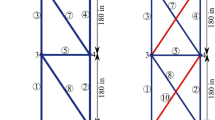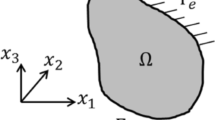Abstract
The semi-analytical method of sensitivity analysis (Zienkiewicz and Campbell 1973; Esping 1983; Cheng and Liu 1987) of finite element discretized structures is attractive due to the balance between computational cost and ease of implementation (Cheng and Liu 1987; Haftka and Adelman 1989), but unfortunately the method may exhibit serious inaccuracies when applied in shape optimization of structures modelled by beam, plate, shell and Hermite elements (Cheng and Liu 1987; Haftka and Adelman 1989; Barthelemyet al. 1988; Barthelemy and Haftka 1988; Choi and Twu 1991, Pedersenet al. 1989; Chenget al. 1989).
In the present paper, we perform an exact analysis of the error of sensitivity for a simple model problem which has earlier been considered by Barthelemyet al. (1988), Barthelemy and Haftka (1988), Pedersenet al. (1989). The analysis gives a deep insight into the nature of the general inaccuracy problem and enables us to devise methods by which the severe error of the sensitivity can be substantially reduced or removed for the model problem. The results of the paper are illustrated via an example.
A method of error elimination for an extended class of semianalytical analysis problems is developed and presented in a companion paper (Olhoff and Rasmussen 1991).
Similar content being viewed by others
References
Barthelemy, B.; Chon, C.T.; Haftka, R.T. 1988: Sensitivity approximation of static structural response.Finite Elements in Analysis and Design 4, 249–265
Barthelemy, B.; Haftka, R.T. 1988: Accuracy analysis of the semianalytical method for shape sensitivity calculation.AIAA Paper 88-2284, Proc. AIAA/ASME/ASCE/ASC Structural Dynamics and materials conf. (held in Williamsburg, VA), Part 1, 562–581. Also:Mech. Struct. Mach. 18, 407–432 (1990)
Cheng, G.; Gu, Y.; Zhou, Y. 1989: Accuracy of semi-analytic sensitivity analysis.Finite Elements in Analysis and Design 6, 113–128
Cheng, G.; Liu, Y. 1987: A new computation scheme for sensitivity analysis.Eng. Opt. 12, 219–235
Choi, K.K.; Twu, S.-L. 1991: On equivalence of continuum and discrete methods of shape sensitivity analysis.AIAA J. (to appear)
Cook, R.D.; Malkus, D.S.; Plesha, M.E. 1989:Concepts and applications of finite element analysis. New York: Wiley & Sons
Esping, B.J.D. 1983:Minimum weight of membrane structures. Ph. D. Thesis. Dept. Aeronautical Structures and Materials, The Royal Institute of Technology, Stockholm, Report 83-1
Haftka, R.T.; Adelman, H.M. 1989: Recent developments in structural sensitivity analysis.Struct. Optim. 1, 137–151
Olhoff, N.; Rasmussen, J. 1991: Method of error elimination for a class of semi-analytical sensitivity analysis problems. In: Eschenauer, H.A.; Mattheck, C.; Olhoff, N. (eds.)Engineering optimization in design processes, pp. 193–200. Berlin, Heidelberg, New York: Springer
Pedersen, P.; Cheng, G.; Rasmussen, J. 1989: On accuracy problems for semi-analytical sensitivity analyses.Mech. Struct. Mach. 17, 373–384
Zienkiewicz, O.C.; Campbell, J.S. 1973: Shape optimization and sequential linear programming. In: Gallagher, R.H.; Zienkiewicz, O.C. (eds.)Optimum structural design, theory and applications, pp. 109–126. London: Wiley and Sons
Author information
Authors and Affiliations
Rights and permissions
About this article
Cite this article
Olhoff, N., Rasmussen, J. Study of inaccuracy in semi-analytical sensitivity analysis — a model problem. Structural Optimization 3, 203–213 (1991). https://doi.org/10.1007/BF01744055
Received:
Issue Date:
DOI: https://doi.org/10.1007/BF01744055




